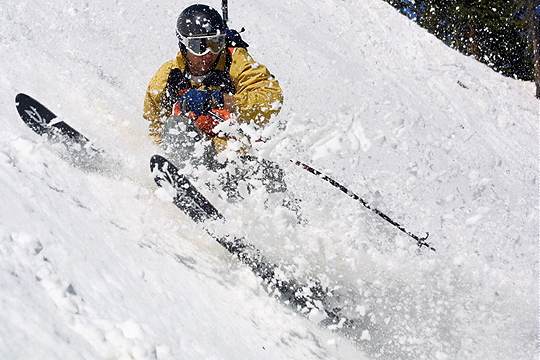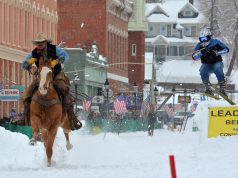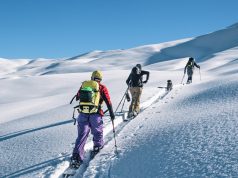
Roy Leckonby is happy. He’s lounging in the corner of a Boulder restaurant, sipping a beer and eating Mexican food. He’s smiling and laughing and soaking up the moment.
“I’m blessed,” he says. And he means it. Leckonby arrived in Boulder to attend the University of Colorado in 1996. A hotshot ski racer, he’d grown up speeding down the icy slopes of New Hampshire and other Eastern states. Fast, focused and talented, he landed in the Mt. Mansfield Academy his junior year of high school, a place with a reputation for turning out elite athletes, including U.S. Ski Team members.
After high school graduation, Colorado, with its top-flight collegiate ski racing program, seemed a natural choice, and Leckonby headed west.
“I started doing the dryland training program for the ski team,” recalls Leckonby, “and then we had our first on-snow day up at Eldora. I looked back at the Indian Peaks and thought to myself, that’s where I want to be skiing, so the next day I quit the ski team, and that was the start of it all.”
While Leckonby may have abandoned racing, he didn’t abandon skiing. That first glimpse of the high peaks scattered along the Continental Divide drew him toward wild terrain like a moth to a candle.
“I wanted to ski that stuff, and I had a roommate in the dorm who had heard about a competition in Crested Butte. It sounded interesting, so we decided to see if we could do it,” Leckonby says.
The competition was, of course, the U.S. Extremes. The contest was first launched in 1991. Rather than the formalized, timed and controlled environment of ski racing Leckonby was a veteran of, the Extremes were radical and fresh. There were limits: Athletes had to stay inside a “venue,” or course, but the venue usually spanned an entire mountain face, and competitors picked their own way down, with points being given by a judging panel for aggressiveness, degree of difficulty of the chosen line and style. For a free spirit such as Leckonby, the chance to do your own thing, on your own terms and against a mountain was irresistible.
“They didn’t have qualifying days or any kind of standard to get in,” Leckonby says of his first freeride competition at Crested Butte. “You had to put together a video or other materials in your application to prove you could ski that kind of terrain, and ski it well. So my buddy and I went up to Berthoud Pass, and jumped off a bunch of cliffs and made a video, and they liked it, and we were in.”
Leckonby ended up with a top 25 finish in his inaugural event, competing against some of the best skiers in the budding discipline. He was hooked.
Over the next five years, big-mountain skiing, as the industry dubbed it, exploded. Along with the Crested Butte event, other contests started popping up: the Berthoud Bad Ass at now defunct Berthoud Pass ski area, The Salomon New Mexico Extremes at Taos, and The Colorado Freeride Championships at Snowmass were complemented by bigger events in Whistler, British Columbia, Snowbird, Utah and more. Leckonby hit the road.
“I was still going to school, and then after school I was working, but I went to them all,” he says. “The Bad Ass Series, Snowmass and Kirkwood.”
And he was skiing well, scoring sixth place on Kirkwood’s challenging and cliffed-out Cirque venue, and always a threat to be in the top 10 anytime he competed.
“I loved the energy, the camaraderie and spirit of the events,” says Leckonby. “The feeling you get when you’re at the start is amazing.”
But along with the energy and the stoke came risk.
By their very nature, bigmountain competitions are dangerous. The terrain that comprises venues is steep, rocky and usually punctuated with cliffs. In some cases, like Crested Butte’s Hourglass or Kirkwood’s Cirque, it’s closed to the general public and illegal to ski. And, unlike the lush powder landscapes of Alaska or Europe, which feature so prominently in ski and snowboard movies that showcase the extreme, competition venues usually have difficult snow conditions, which get increasingly chewed up during the course of events.
These factors up the consequence level for falls or other mistakes. While most events go off with only minor injuries, tragedy has struck several times. Last year, 25-year-old Ryan Hawks died after a crash at Kirkwood, and in 2008, Colorado skier John Nicoletta died after crashing at another event at Alyeska, Alaska.
The deaths reflect the rowdy evolution of a sport, where athletes now ski bigger and steeper lines, with more speed and aggression than anyone could have imagined. And one of these athletes was Leckonby.
It’s 2008, a month or so before the Nicoletta tragedy, and Leckonby is at Taos for the Salomon New Mexico Extremes. He’s made it deep into the competition, a three-day affair where athletes move to progressively more difficult venues, with only the top finishers from each day advancing. The “cut,” as it’s called, is one way for event organizers to minimize the risk. Cull the lesser-skilled athletes from the pack each day, and only those who have the skills and ability will end up skiing on the final and most difficult venue, Kachina Peak. Leckonby has made the cut, and he’s on Kachina.
He chooses one of the most exposed lines, in a zone called The Dive. Before this event, and the athletes who began to flock here every year to test themselves, The Dive didn’t get skied. Ever.
Today, the rocky buttress with mandatory cliff drops to exit it is the zone of choice for competitors who want to do well in the event. Everything else on Kachina’s face is just too easy, even the 40- or 50-foot airs into avalanche chutes.
Leckonby tees up his final drop, he launches, but misjudges the off-camber landing, slams into a rock outcropping head first and then hangs, limp, off the mountainside, unmoving, obviously unconscious.
Due to its steep, rocky terrain, Taos has one of the best high-angle rescue teams in the country. Usually, it’s tourists they’re plucking out of places they shouldn’t be, but this is serious. The team goes to work. Within 30 minutes, Leckonby is off the mountain and headed for the hospital. The event goes on without him and Telluride’s Jake Cohn will eventually claim the winner’s trophy in a beer-soaked celebration, as the event management announces that Leckonby is alive and will be OK.
But will he? Five days later, Leckonby woke up. Back at the restaurant in Boulder, he recalls, “I fractured my C5, 6 and 7 vertebrae and sustained moderate traumatic brain injury on the crash,” he says. “And with a closed brain injury like that, it’s hard to realize the significance of that kind of injury.”
“Everything is blank,” he says of the crash. “I have no memories of it at all.”
Leckonby holds up his helmet. It’s severely damaged, with large dents.
“This,” he says. “This is what saved my life.”
The words are clear and confident.
But Leckonby’s ability to articulate is the result of a year of grueling rehab, and he’ll never compete at the highest levels again.
“A lot of the time during the rehab period I didn’t really understand or comprehend the injury,” admits Leckonby. “Then I watched the video of the crash, and I realized just how badly I hurt myself.” (Editor’s note: the video is available on YouTube for those who are interested.)
According to medical experts, injuries like the one Leckonby sustained are complex, with recovery processes that differ from individual to individual. Often, recovery is termed a “functional recovery,” and is based upon mechanisms that are uncertain. The goal of medical support teams is to give the victim the opportunity to live a more or less “normal” life. In some cases, this is impossible, and in many cases, the lingering effects of a traumatic head injury preempt the normality of the victim’s pre-accident existence. A victim’s personality can be irrevocably changed or damaged, their cognitive skills may never fully return or they may be unable to resume full-time employment. Four years after his accident, Leckonby seems to have dodged a very big bullet. He’s back at work full time, has his old personality back and has been given the final OK by his medical team.
Still, the recovery process was tough.
“I wasn’t allowed to do much,” says Leckonby. “The biggest part was the mental exhaustion. I’d feel fine but would get totally exhausted from the tiniest effort of thinking. It was incredibly slow.” “One thing about my recovery was how great everyone around me was,” Leckonby says. “A lot of people stepped up, but no one more than my girlfriend Tiffany. She was watching the live web cast, saw the crash and sprang into action. That was the beginning of a long journey for her, too, as she was doing everything for me. I was incapable of doing all the day-to-day activities people take for granted. Even sleeping was difficult.”
Going back to work was a significant step.
“It was such a milestone, but it was only six hours of work a week,” he says. “A week, six hours! And that was almost more than I could handle.”
But perhaps most importantly, Leckonby is skiing again.
“I was born to ski, I love it,” he says.
“Skiing brings it to the surface of how lucky I am, I am so appreciative of everything. I’m no longer competing, but I want to still be involved in the sport, and that is enough for me.”
He sits back in his seat, the story over, his beer still half full.
“There’s a certain purity in just sliding on snow,” he says, and smiles. “I’m lucky. Very lucky.”














